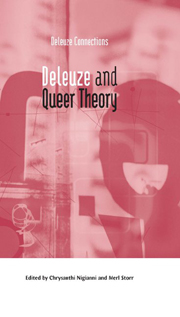Book contents
- Frontmatter
- Contents
- Introduction
- 1 On the Very Possibility of Queer Theory Claire Colebrook
- 2 Thirty-six Thousand Forms of Love: The Queering of Deleuze and Guattari
- 3 The Sexed Subject in-between Deleuze and Butler Anna Hickey-Moody and Mary Lou Rasmussen
- 4 Every ‘One’ – a Crowd, Making Room for the Excluded Middle
- 5 The Adventures of a Sex
- 6 Queer Hybridity
- 7 Prosthetic Performativity: Deleuzian Connections and Queer Corporealities
- 8 Unnatural Alliances
- 9 Schreber and the Penetrated Male
- 10 Butterfly Kiss: The Contagious Kiss of Becoming-Lesbian Chrysanthi Nigianni
- Notes on Contributors
- Index
8 - Unnatural Alliances
Published online by Cambridge University Press: 12 September 2012
- Frontmatter
- Contents
- Introduction
- 1 On the Very Possibility of Queer Theory Claire Colebrook
- 2 Thirty-six Thousand Forms of Love: The Queering of Deleuze and Guattari
- 3 The Sexed Subject in-between Deleuze and Butler Anna Hickey-Moody and Mary Lou Rasmussen
- 4 Every ‘One’ – a Crowd, Making Room for the Excluded Middle
- 5 The Adventures of a Sex
- 6 Queer Hybridity
- 7 Prosthetic Performativity: Deleuzian Connections and Queer Corporealities
- 8 Unnatural Alliances
- 9 Schreber and the Penetrated Male
- 10 Butterfly Kiss: The Contagious Kiss of Becoming-Lesbian Chrysanthi Nigianni
- Notes on Contributors
- Index
Summary
Gilles Deleuze and Félix Guattari use as a key example of becomings becoming-animal. Becoming-animal involves both a repudiation of the individual for the multiple and the human as the zenith of evolution for a traversal or involution across the speciesist plane of consistency. Deleuze and Guattari delineate the Oedipal animal, the pack animal and the demonic hybridisation of animal, human and imperceptible becomings. Various commentators have critiqued and celebrated Deleuze and Guattari's call to becoming-woman. In his taxonomy of living things Aristotle places women at the intersection of animal and human, so becoming-animal as interstices raises urgent feminist issues as well as addressing animal rights and alterity through becoming-animal. This chapter will invoke questions such as ‘how do we negotiate becominganimal beyond metaphor?’, ‘what risks and which ethics are foregrounded that make becoming-animal an important political project?’ and, most importantly, because becoming-animal is a queer trajectory of desire, ‘how does the humanimal desire?’
Anthropomorphism can go either up or down, humanising either the deity or animals, but if the vertical distance is closed in any way, i.e. between God and humans or humans and animals, many are disconcerted.
(Adams 1995: 180)For on the one hand, the relationships between animals are the object not only of science but also of dreams, symbolism, art and poetry, practice and practical use. And on the other hand, the relationships between animals are bound up with the relations between man and animal, man and woman, man and child, man and elements, man and the physical and microphysical universe.
(Deleuze and Guattari 1987: 235)- Type
- Chapter
- Information
- Deleuze and Queer Theory , pp. 134 - 149Publisher: Edinburgh University PressPrint publication year: 2009

